致用英语英语国家概况-Australia
- 格式:ppt
- 大小:3.03 MB
- 文档页数:15
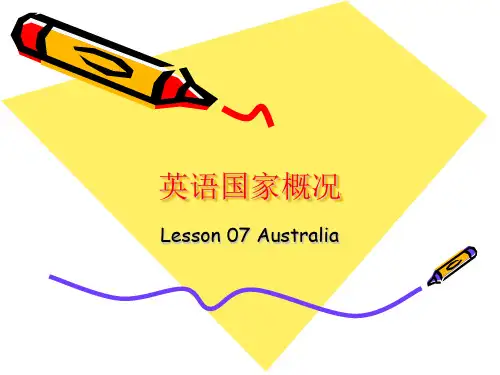
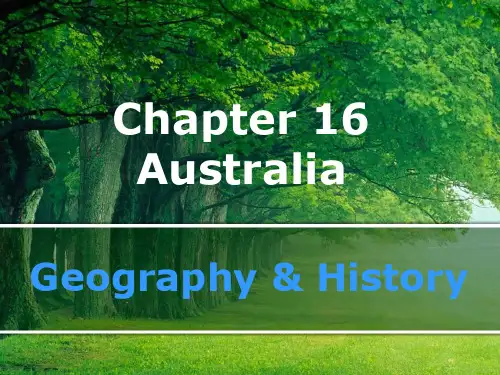
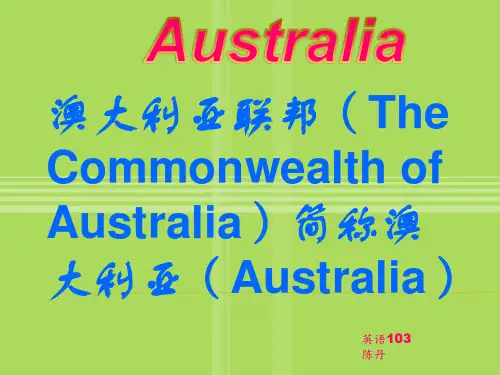

介绍澳大利亚的英语作文_IntroduceAustralia 3篇导读:关于”介绍澳大利亚“的英语作文范文3篇,作文题目:Introduce Australia。
以下是关于介绍澳大利亚的小学英语范文,每篇作文均为满分范文带翻译。
关于”介绍澳大利亚“的英语作文范文3篇,作文题目:Introduce Australia。
以下是关于介绍澳大利亚的小学英语范文,每篇作文均为满分范文带翻译。
高分英语作文1:Introduce AustraliaAustralia, located in the southern hemisphere, is the largest country in Oceania. It is bordered by the Pacific Ocean in the East and the Indian Ocean in the West. There are a large number of islands around the territory, which are about km long.The population is about 10000. Among them, the earliest are the descendants of the British and Irish people. Most of them come from the United Kingdom for most of the year.The climate is warm and pleasant. Most of the population lives on the southeast coast of Australia Pella is the capital of Australia and Sydney is the largest city. Australia is rich in natural resources and developed lions of tourists come here every year.中文翻译:澳大利亚位于南半球,是大洋洲中面积最大的,东濒太平洋,西濒印度洋,领土周围有大量岛屿,约有公里,人口约万,其中最早的是英国人和爱尔兰人的后裔xx年中大部分时间都是从英国来的移民,气候温暖宜人,大部分人口居住在澳大利亚东南海岸堪培拉是澳大利亚的首都,悉尼是最大的城市。


英语国家概况(澳大利亚)Some General FactsNames of the CountryThe Commonwealth of AustraliaDown UnderThe Lucky CountryThe Sunburned CountryOzThe Land of WonderThe Land of PlentyThe Land of the Long WeekendOrigins of the Country’s NicknameExcerpt from “Down Under”On a hippie trail, head full of zombieI met a strange lady, she made me nervousShe took me in and gave me breakfastand she said,“Do you come from a land down under? Where women glow and men plunder?Can't you hear, can't you hear the thunder?You better run, you better take cover."Christian Shephard :Australia is called "Down Under" because it's as close as you can get to Hell without getting burned.Origins of the Country’s NicknameMaking of the CountrySix States◆ New South Wales (Sydney)◆ Queensland (Brisbane)◆ South Australia (Adelaide)◆ Western Australia (Perth)◆ Victoria (Melbourne)◆ Tasmania (Hobart)Two Territories◆ Australian Capital Territory◆ Northern Territory (Darwin)Political Figures of the CountryHead of state: Sovereign(最高统治者)Queen Elizabeth IIGovernor-General: Michael JefferyHead of government: Prime Minister Kevin Michael RuddNational Anthem of the CountryAdvance Australia FairAustralians all let us rejoice,For we are young and free;We’ve golden soil and we alth for toil; Our home is girt(围绕)by sea;Our land abounds in nature’s giftsOf beauty rich and rare;Advance Australia Fair.In joyful strains then let us sing, Advance Australia Fair.Beneath our radiant Southern CrossW e’ll toil with hearts and hands;To make this Commonwealth of ours Renowned of all the lands;For those who’ve come across the seas We’ve boundless plains to share;With courage let us al l combineTo Advance Australia Fair.In joyful strains then let us sing, Advance Australia Fair.National Color of the CountryYellow GreenNational Flora(植物)of the Country Golden Wattle(向日葵)National Flag of the CountryThe Coat of Arms of AustraliaNew South Wales - Golden Lion St George's CrossVictoria - Southern Cross Imperial CrownQueensland - Maltese Cross Imprerial CrownSouth Australia - White-Backed MagpieWestern Australia - Black SwanTasmania(塔斯马尼亚岛)- Red LionCoins and Bank NotesNational Holidays of the CountryAustralia DayAnzac Day C 25 April or, if that day falls Sunday, the following Monday May Day C the first Monday in MayQueen’s Birthday C the second Monday in JunePicnic Day C the first Monday in AugustOther Facts and FiguresPopulation: 20,351,000Capital: Canberra; 373,000Area: 7,692,024 square kilometers (2,969,906 square miles)Language: English, native languagesReligion: Protestant, Roman CatholicCurrency(货币): Australian dollarLife Expectancy(期望): 80GDP per Capita(人数): U.S. $26,900Literacy(读写能力)Percentage: 100Ethnic(人种的)groups:1. White 92%2. Asian 7%3. Aboriginal others 1%Religions:Roman Catholic(天主教)26%, Anglican 21%Christian 21%, Buddhist 2%Islam 2%, others 1%History of the Continent200 million years agoC Australia was attached to Pangaea(大陆).Between 200 and 65 million years agoC Pangaea separated to form Gondwanaland and Laurasia.50 million years agoC Gondwanaland broke up into southern continents with Antarctica and Australia attached.40 million years agoC Australia broke away from Antarctica.Geological Regions of the CountryEastern Highlands◆ The Great Dividing Range◆ The Coastal PlainCentral Lowlands◆ Lake EyreWestern Plateau◆ Large Deserts◆ Ancient RocksThe Dividing Range◆ Stretching along the eastern coast◆ Containing the highest mountain of Australi a CMt. Kosciuszko/Kosiusko (2,228 m)◆ Bordered by sandy(游牧的)beaches and rocky cliffs Lake Eyre◆ Largest lake in the country (9,600 sq km)◆ Lowest point in the continent (12 m)◆ A salt water lake in the arid(干旱的)interiorHistory of the CountryThe First ImmigrantsAborigines C Nomadic Hunters and Gatherers◆ Coming from Asia 50,000 years ago◆ Reaching Tasmania 35,000 years agoHunting and Obtaining Food with Tools and Weapons◆ Core(挖掘)Tools; Grinding(磨的)Stones; BoomerangAboriginal Society◆ Nomadic and kinship band◆ Laws and beliefs upheld(支持)by song, dance and art◆ Without formal system of government◆ Oral tradition and The Dreaming (Dreamtime)How to get a flake from a coreGrinding StoneHatchets Made from Ground-StoneAborigines with BoomerangAboriginal and Modern BoomerangsThe Dutch DiscoveryWillem Janszoon C a Dutch Navigator(航海家)◆ The first recorded European sighting of theAustralian mainland (1606)◆ The first recorded European landfall on theAustralian continentThe Chart of Western and Northern Coast-lines of AustraliaAbel Tasman C a Dutch Explorer◆ The success of sailing into the waters of southern Austra lia (1642) ◆ The discovery of the island Tasmania17th century map of Tasmania, showing the parts discovered by Tasman.The Colonization of AustraliaIn 1768 British Captain James Cook set off to find Australia in the Endeavour .In 1770 King George III claimed possession of the east coast, named New South Wales.On 26 Jan. 1788 the First Fleet arrived in Sydney Cove with 736 convicts. Tasmania became a separate colony in 1825.South Australia in 1836, Victoria in 1851, and Queensland in 1859.South Australia, Victoria and Western Australia were founded as "free province".The Northern Territory(领土)was founded in 1911.The Indigenous(本土的)Australian population declined steeply due to infectious disease.The “Stolen Generations” may have contributed to the decline.The “History Wars”The 1850s Gold RushGold was found in New South Wales and Victoria in 1851.By the 1880s, Australia was a prosperous(繁荣的)country.The final decade of the 19th century was a period of depression.Federal BeginningsThe federation of six colonies formed the Australian nation on 1 January 1901.The “White Australia” Policy was legislated(立法)by the new parliament. ◆ A dictation(命令)test in a European language Three major political groups and two major parties.◆The Protectionists, the Free Traders and the Labor PartyThree major political groups Two major parties.◆ The Protectionists◆ The Free Traders◆ The Labor PartyTwo major parties.◆ The Labor Party◆ The Liberal PartyWorld War IIn 1914, Australia entered WWI to defend Britain.◆ With 64 percent of the 331,781 troops killed or wounded◆ Anzac Day commemorates the landing of the Australian and New Zealand Army Corps at Gallipoli in Turkey on the 25th April 1915. Between the WarsDuring the 1920s, Australia entered a period of major development.◆ Queensland and Northern Territory Aerial Service Ltd. was formed in 1920.◆ Building of the Sydney Harbour Bridge began in 1923.◆ The population reached 6 million in 1925.In 1929 Australia went into economic decline.◆ Wool and wheat prices fell dramatically.◆ By 1931, a third of the country was unemployed.Prices began to increase again by 1933 and manufacturing revived. From 1934 to 1937 the economy improved and unemployment fell. World War IIAustralians again fought in defence of freedom and the “mother land.”In 1942 Darwin, Broome and Townsville were bombed by the Japanese, and two Japanese midget(小型的)submarines entered Sydney Harbour.A major shift in Australian foreign policy away from Britain and towards the USA occurred.In 1951, Australia signed its first defense treaty with a foreign country: the ANZUS treaty.Nearly one million of Australia’s seven million population went to fight. ◆ 34,000 killed and 180,000 woundedPostwar ImmigrationThe postwar immigration programme welcomed not only British immigrants but also Europeans.In 1956, th e status of “permanent resident” allowed non-Europeans to claim citizenship(国籍,公民权).The Menzies Era(时代)From 1949 until 1966, Prime Minister Robert Menzies “reigned”, winning 8 consecutive(连续的)elections.Menzies gave Australians conservatism(保守主义)and stability (坚定). He involved Australians in three more wars, in Korea (1950), Malaya(马来亚)(1955) and Vietnam (1965).Social Unres(动荡)t and ChangesOpposition to conscriptio(征兵)n and the Vietnam War increased in the late 1960s and led to major demonstrations in the capital cities.There was concern for Aboriginal land rights and free education. In 1972, the Labor Party was elected on a platform of social reform.In 1974, an immigration policy without any racial(种族的)discrimination(歧视)was adopted.Return to ConservatismGovernments were more concerned with economic rather than social agendas .Australia emulated most of the Western world with an economic boom(繁荣)in the 1980s, followed by recession(衰退)in the 1990s.By 1986, all legislative(立法机构)ties with Great Britain were broken. The year 2022年saw Sydney host the Summer Olympic Games.Politics of the CountryFeatures of GovernmentA constitutional(宪法的)monarchy(君主政体)◆ The King or Queen of Brita in as the King or Queen of Australia.◆ The Commonwealth of Australia Constitution Act, coming into effect in 1901, consists of 8 chapters.A federation(联邦)◆ 6 colonies and 2 territories federated to form the Commonwealth of Australia.A parliamentary democracy◆ The Parliament of the Commonwealth consists of the King or Queen and 2 houses◆ The Senate (the Upper House) consists of 76 Senators, 12 from each of the 6 states and 2 from each of the territories.◆ The House of Repre sentatives (the Lower House) has 150 members.A parliamentary democracy◆ The Senators are elected by a system of propor-tional representation for a term of 6 years.◆ Members of the Lower House are elected by a system of preferential voting for terms of up to 3 years.◆ 3 important electoral systems in Australia C the simple majority system, the preferential represen-tation system and the proportional (比例)representation system.The simple majority systemIt is a straightforward(明确的)form of voting, by which the option with a simple majority of votes wins.The preferential(优先的)representation systemUnder such a system voters rank candidates in order of preference. The proportional representation systemUnder such a system, the percentage of votes that groups of candidates obtain will determine the percentage of seats they receive.Systems of Government3 levels C a three-tier system◆ The federal government at the national level◆ Governments at the state a nd territory level◆ Locale governments at the city, town, municipal(市政的)and shire (郡)level.3 branches C the separation of powers◆ The legislature(立法机关)C the Parliament(议会)◆ The executive(执行委员会)C the Governor-General / the Federal Executive Council◆ The judiciary C the High Court and other federal courtsPolitical Parties3 major political parties◆ The Labor Party◆ The Liberal Party◆ The National PartyA 2-party system◆ The Labor Party◆ The Coa lition(结合,联合)of Liberal Party and National Party November 2022年, Kevin Rudd from the Labor Party became the 26th Prime Minister of Australia.Economy of the CountryHaving one of the most outstanding(杰出的)economies of the world; With a high-growth, low-inflation, low interest rate;With a flexible labor market and a competitive business sector(部门); Abundant physical resources leading to a high standard of living. Having made a large investment in social infra-structure ;With mining and farming as major industries;◆ coal, copper, gold and iron ore(矿石)◆ sugarcane, grapes and wheat◆ sheep and cattleTourism as one of Australia’s largest and fastest-growing industries.EnvironmentMuch of Australia's flora and fauna(动物群,动物区系) is unique and diverse(多种多样的).◆ About 85% of flowering plants, 84% of mammals, more than 45% of birds, and 89% of in-shore, temperate-zone fish are endemic.◆ Australia has the greatest number of reptiles(爬行动物)of any country, with 755 species.Australian forests often contain a wide variety of eucalyptus(桉树)trees and are mostly located in higher rainfall regions.Among well-known Australian fauna are the monotremes(单孔目动物)(the platypus(鸭嘴兽)and the echidna(针鼹鼠)); a host(群集)of marsupials(有袋动物); the saltwater and fresh-water crocodiles (鳄鱼); and birds such as the emu(鸸鹋)and the kookaburra(笑翠鸟).Environmental concerns over climate changes, enthreatened species, and water restrictions.。
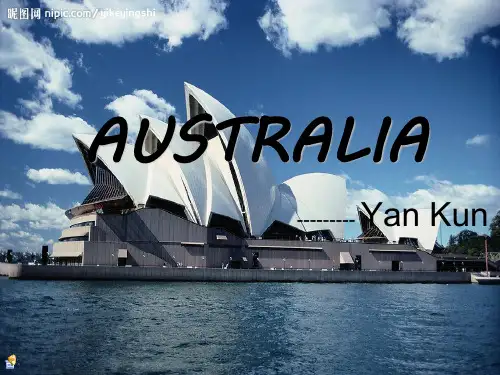
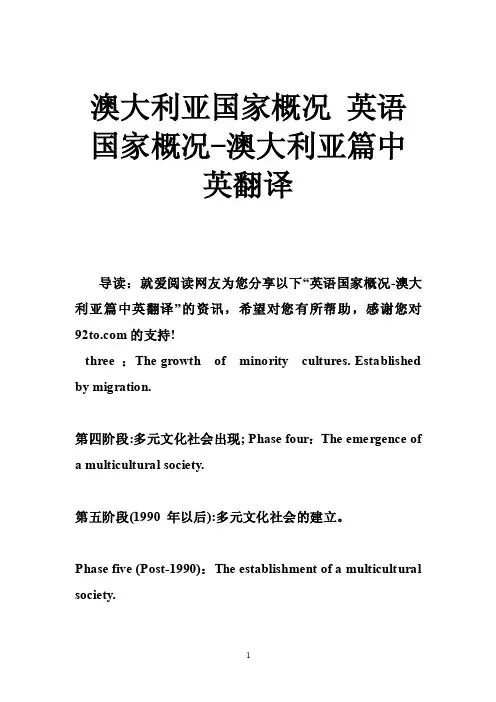
澳大利亚国家概况英语国家概况-澳大利亚篇中英翻译导读:就爱阅读网友为您分享以下“英语国家概况-澳大利亚篇中英翻译”的资讯,希望对您有所帮助,感谢您对的支持!three :The growth of minority cultures. Established by migration.第四阶段:多元文化社会出现; Phase four:The emergence of a multicultural society.第五阶段(1990 年以后):多元文化社会的建立。
Phase five (Post-1990):The establishment of a multicultural society.多元文化社会的建立是由于: multicultural society established by:(1)立法; legislation;(2)代表权; representation;(3)承认土著文化的价值和所有后来移民文化的贡献; recognition of value of original culture and contributions and all subsequent migrating cultures;(4)容忍和接受澳大利亚的文化差异及这种差异与澳大利亚社会的关系;tolerance and acceptance of Australia's cultural diversity and its relationship to Australia's social context.1.土著文化Aboriginal culture他们的历书是分季节的和循环的; 土著人信奉梦幻时代。
这里的大部分的传统文化到20世纪中期都已失去了。
Their calendar was seasonal and cyclical: The Aboriginal people believed in the Dreamtime. the traditional culture had been lost by the mid-twentieth century.2.现代澳大利亚文化Modern Australian culture现代澳大利亚文化是许多传统和多种影响的重叠与混合物:英国的、美国的、欧洲的和亚洲的。
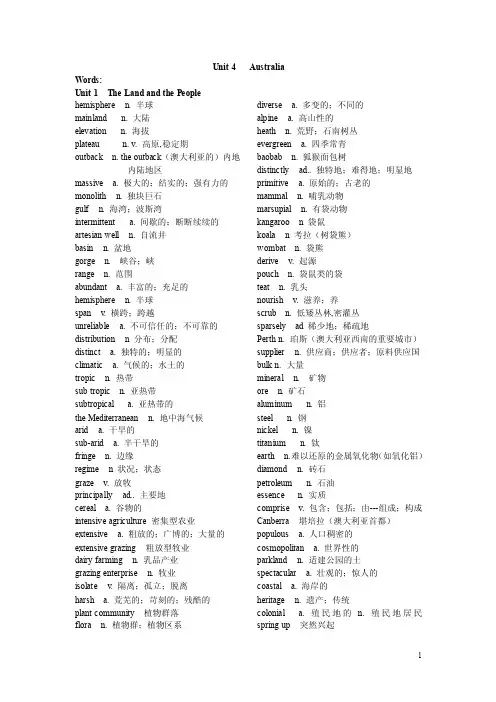
Unit 4 Australia Words:Unit 1 The Land and the Peoplehemisphere n. 半球mainland n. 大陆elevation n. 海拔plateau n. v. 高原,稳定期outback n. the outback(澳大利亚的)内地内陆地区massive a. 极大的;结实的;强有力的monolith n. 独块巨石gulf n. 海湾;波斯湾intermittent a. 间歇的;断断续续的artesian well n. 自流井basin n. 盆地gorge n. 峡谷;峡range n. 范围abundant a. 丰富的;充足的hemisphere n. 半球span v. 横跨;跨越unreliable a. 不可信任的;不可靠的distribution n 分布;分配distinct a. 独特的;明显的climatic a. 气候的;水土的tropic n. 热带sub tropic n. 亚热带subtropical a. 亚热带的the Mediterranean n. 地中海气候arid a. 干旱的sub-arid a. 半干旱的fringe n. 边缘regime n 状况;状态graze v. 放牧principally ad.. 主要地cereal a. 谷物的intensive agriculture 密集型农业extensive a. 粗放的;广博的;大量的extensive grazing 粗放型牧业dairy farming n. 乳品产业grazing enterprise n. 牧业isolate v. 隔离;孤立;脱离harsh a. 荒芜的;苛刻的;残酷的plant community 植物群落flora n. 植物群;植物区系diverse a. 多变的;不同的alpine a. 高山性的heath n. 荒野;石南树丛evergreen a. 四季常青baobab n. 狐猴面包树distinctly ad.. 独特地;难得地;明显地primitive a. 原始的;古老的mammal n. 哺乳动物marsupial n. 有袋动物kangaroo n 袋鼠koala n 考拉(树袋熊)wombat n. 袋熊derive v. 起源pouch n. 袋鼠类的袋teat n. 乳头nourish v. 滋养;养scrub n. 低矮丛林,密灌丛sparsely ad 稀少地;稀疏地Perth n. 珀斯(澳大利亚西南的重要城市)supplier n. 供应商;供应者;原料供应国bulk n. 大量mineral n. 矿物ore n. 矿石aluminum n. 铝steel n. 钢nickel n. 镍titanium n. 钛earth n.难以还原的金属氧化物(如氧化铝)diamond n. 砖石petroleum n. 石油essence n. 实质comprise v. 包含;包括;由---组成;构成Canberra 堪培拉(澳大利亚首都)populous a. 人口稠密的cosmopolitan a. 世界性的parkland n. 适建公园的土spectacular a. 壮观的;惊人的coastal a. 海岸的heritage n. 遗产;传统colonial a. 殖民地的n. 殖民地居民spring up 突然兴起federation n. 联邦;联邦政府Bass Strait 巴斯海峡hydroelectric a. 水力发电的inn n. 旅馆;客栈era n. 时代reputation n. 名声renowned a. 著名的;有声望的yacht n. 游艇;快艇racer n. 比赛Hobart n. 霍巴特(塔斯马尼亚首府)aborigine n. 土著人Brisbane n. 布里斯班Adelaide n. 阿德莱德ethnic a. 人种学的aborigine n.. 土著居民proportion n. 比率territory n. 领土;领地;领域urbanize v. 使都市化populous a. 拥挤的;人口稠密的unify v. 使一致;统一totem n. 图腾像kinship n. 相似的affinity n. 吸引力;亲密关系marginalize v. 忽视;忽略forcibly ad 强行地disperse v. 驱散;分散;使四下散开Unit 2 Historyhabitation n. 住所penal a. 刑事的alleviate v. 减轻hold-up 阻碍habitual a. 经常convict n. 囚犯slum n. 贫民窟offender n. 触犯者prevalent a. 普遍的;流行的etch v. 铭记;蚀刻lineage n. 家系;宗系stain n. 耻辱;瑕疵descend v. 降格;下降demography n. 人口统计学aftermath n. 后果economic depression 经济萧条triple v. 增至三倍formation n. 组成semi-skilled a. 半熟练的capable a. 有能力有才能informed a. 有学识的squatter n. 擅自占用他人房子(或土地)jury n. 陪审团mount v. 增加say n. 发言权constitution n. 宪法parliament n. 议会;最高法院aborigine n. 土著居民original a. 土著的ballot n. 选票;投票数catastrophe n. 大灾难indigenous a. 本地的conquest n. 攻占;征服smallpox n. 天花measles n. 麻疹influenza n. 流行性感冒vitality n. 生命力exemplify v. 举例;说明craft n. 行会stonemasons n. 石匠shearer n. 修剪工wharf n. 码头discernible a. 区别的dissatisfied a. 不满意的;不高兴的resurgence n. 再现;复活;再起fundamental a. 基本的;根本的motherhood n. 母性;母亲身份conservation n. 保存;保持;保护surge n. 巨涌;大浪;汹涌澎湃conservatism n. 守旧性;保守主义legislation n. 立法;法律privatization n. 私有化nationalist n. 民族主义者;国家主义者;sentiment n. 感情;情绪;观点;情操logo n. 商标,徽标;标识语identity n. 身份;同一性,一致;恒等式constitutional a. 宪法的;n. 保健散步monarchy n. 君主政体;君主政治;君主pinnacle n. 小尖塔;尖峰;高峰;极点v. 造小尖塔;置于尖顶上;置于高referendum n. 公民投票权prior a. 在先的;在前的poll n. 民意测验;投票;投票数;投票engagement n. 约会;交战;婚约;诺言minimalist n. 极简抽象派艺术家;最低限proposal n. 提议;建议;求婚radical a. 根本的;激进的;彻底的prominent a. 突出的,显著的;杰出的tremendous a. 极大的,巨大的;惊人的maintain v. 维持;维修;供养;继续engage v. 雇佣;吸引;占用;使订婚strategic a. 战略上的;战略的investment n. 投资;投入taxation n. 课税,征税;税款telecommunication n. 电讯;远程通信outsource v. 把…外包sustain v. 支撑;承担;维持;忍受coalition n. 联合;结合,合并parliamentary a. 议会的;国会的federal a. 联邦的;同盟的pledge n. 抵押;保证;抵押品;典当物initiate v. 开始,创始;发起Unit 3 Economyreign v. 统治;盛行infertile n. 贫瘠的livestock n. 家禽graze v. 放牧;喂草constitute v. 构成cereal n. 谷类食物concentrated a. 浓缩的;集中的sugarcane n. 甘蔗temperate a. 温带的tropical a. 热带sorghum n. 高梁oilseeds n. 亚麻子plantation n. 种植园pulp n. 浆状物;纸浆;果肉consolidated a. 加固的marine a. 海生的comparatively a. 相对的lobster 龙虾n.prawn n. 明虾abalone n. 石决明(鲍鱼)tuna n. 金枪鱼scallop n. 扇贝edible a. 可以食用的bream n. 鲤科淡水鱼cod n. 鳕鱼flathead n. 扁头鱼mackerel n. 鲭鱼perch v. 鸟的栖息地salmon n. 三文鱼category n. 类别tantalum 【化】钅旦uranium 【化】铀zinc 【化】锌deposit n. 放置;使沉淀;贮藏cobalt 【化】钴manganese 【锰】nickel 【锰】鎳metallic a. 金属制品的aluminum 【美】铝substantial a. 物质的,实质的,本质的textile n. 纺织业;纺织品appliance n. 用具;器具;装置jet aircraft 喷气式飞机synthetic fiber 合成纤维hydroelectric power 水力发电petrochemical a. 石油化学的smelted aluminum 精炼的铝phosphate fertilizer 磷肥pastoral a. 田园的power cable 电缆electrolytic a. 电解的confectionery n. 甜食生产业bureau n. 局vigorous a. 蓬勃的winery n. 酿酒厂closure n. 关闭停工sponsor n. 赞助商transoceanic a. 横渡海洋的monopoly n. 垄断权hallmark n. 特点utility n. 公用事业implementing a. 执行性的oversee v. 监督engagement n. 保证federal a. 国家的multilingual a. 使用多种语言的affiliated with 与….有密切联系minority n. 少数noteworthy a. 值得注意的export-orient a. 面向出口的implement n. 工具colonial a. 殖民地当的diverse a. 不同的monetary a. 金融的Unit 4 Government and Politicsframework n. 构架;结构democracy n. 民主制度;民主政体monarchy n. 君主制virtual a. 实际上的enact v. 制定(法律)concurrent a. 并存的;同时发生的;一致的discharge v. 允许离开impeachment n. 弹动senate n. 参议院chamber n. 立法机关;议会dissolution n. 解散scrutinize v. 详细检查taxation n. 征税;税款originate v. 开始;发源reside v. 居住;定居ultimate a. 最终的;最后的inquiry n. 打听;询问incompetence a. 不胜任safeguard v. 保护;维护corrupt a. 贪污的;腐败的expenditure n. 支出;开支derive v. 源于从…取得constitutional a. 受宪法限制的;有关宪法的coalition n. 联盟exert v. 运用expertise n. 专门技能ratification n. 签署;批准delegate n. 代表;授权于ritual n. 仪式;例行习惯statutory a. 法定的colony n. 殖民地ideological a. 思想体系的inaugurate v. 为…举行就职典礼eligible a. 允许做…的personnel n. 全体职员turnout n. 出席人数stipulate v. 规定;讲明judiciary n. 司法部tenure n. 任期使用权validity n. 具有法律效力有效tribunal n. 审裁团maintenance n. 保养维修赡养费抚养费matrimonial a. 婚姻生活的custody n. 监护权Intermediate n. 中间的中级的magistrate n. 地方法官hierarchy n. 等级制度Unit 5 Social and Cultural life institutionalize v. 制度化vestige n. 遗迹,痕迹assimilation n. 同化implement v. 实施,执行n. 工具,器具catchword n. 口号cohesion n. 凝聚Australia Institute of Multicultural Affair (AIMA)澳大利亚多元文化交流事务所cohesion n. 凝聚populist n. 民粹主义marginalize v. 边缘化tertiary a. 三级的Bachelor's degree 学士学位graduation thesis 毕业论文postgraduate 研究生master's degree 学士学位doctorate n. 博士学位competency n. 能力,胜任distribution n. 分布notable a. 显着sparsely ad. 人口稀少maternity n. 产假psychiatric n. 精神科impairment n. 减值disperse v. 驱散Herald Sun先驱太阳报Sun News Pictorial 太阳新闻画报genre n. 类型yacht n. 游艇netball n. 投球aussie n. 澳元;澳大利亚人metropolitan n. 大都市orchestra n. 乐队Good Friday n. 耶稣受难日commemorate v. 纪念The Adelaide Festival of Art:阿德莱德艺术节ExercisesUnit 11. What are the most prominent physical features of the Australian continent?It was divided into three physically distinct regions: the western plateau, the central lowlands and the eastern highlands. The western plateau is a vast desert and semi-desert region that covers about 60 percent of the land area, located on the plateau are the coun try’s four major deserts: the Gibson, Great Sandy, Great V ictoria and Simpson. The central lowlands stretch from the gulf of Carpentaria in the north to the western Victoria in the south, accounting for about one forth of Australia. The climate is hot rainfall is frequently. The eastern highlands extend from the Cape Y ork, Peninsula in north-eastern Australia to the southern coast of Tasmania and covers about 15 percent of Australia2. How is Australia geographically divided?The Australia continent can be divided into three physically distinct regions: the West Plateau,the Central lowlands, and the Eastern highlands.3. What are the major characteristics of these geographical regions?(1) The Western Plateau is a vast desert and semi-desert region that covers about 60 percent of the land area. Most of the land is flat.(2)The Central Lowlands: the land is generally flat with an average elevation of only 152 meters. The climate is hot; rainfall is infrequent; much of the land is dry and desert and many of the rivers flow only intermittently.(3)The Eastern Highlands consist mainly of high plateaus with many gorges, hills and low mountain ranges.4. What are the distinctive features of Australian climate?(1) “The land in the sun”: Australia has an average of 5 hours of sunshine daily. Most of the land enjoys abundant sunshine.(2) Located in the southern hemisphere, Australia has the seasons opposite to those of the northern hemisphere.(3) Generally, Australia is a dry continent, where rainfall is unreliable. The distribution of the rainfall is rather uneven with the high rainfall in the north, the east and the southwest coasts.5. How does climate influence Australian agriculture?Agriculture land use is heavily influenced by this climate regime. Generally, the tropical north is suited to grazing, principally cattle, as well as the production of fruit and sugarcane. The major land uses in the subtropical and Mediterranean climates in the south are cereal cropping as well as sheep and cattle grazing. The Murray-darling basin in the southeast has a large irrigationinfrastructure, supporting the production of fruit, vegetables, rice and many other intensive agricultural activities. Agriculture in the arid zone involves extensive grazing, where sheep and cattle are reared at relatively low densities if less than one sheep per 10 heads. The higher rainfall zones are suitable for dairy farming as well as more intensive grazing enterprises that produce meat.6. What make the Australian continent home to a variety of unique native plants and animals?Australia has been isolated for thousands of years, thus, plants and animals have been able to develop independently to suit the often harsh natural conditions. Due to the wide ridge of different environments and plant communities, the native flora of Australia is the most diverse and varied in the world, growing in tropical rainforest, stony inland deserts, alpine meadows and sandy heath lands.The animals of Australia are particularly interesting, because many of them are distinctly primitive. There are groups of animals whose relatives have long since disappeared from other parts of the world. Many of the animals found in this country are unique. Australia is home to a variety of native mammals, both on land and in the surrounding oceans.7. To what extent have climate and environmental factors influenced the pattern of population settlement in Australia?As the northern and central parts of Australian continent are generally hot and dry and unable to support a large population, more than 80 per cent of Australians settle in the cooler coastal regions.8. Who are the indigenous peoples of Australia? And what are their major traditions?Aus tralia’s i ndigenous population is composed of aboriginal peoples and Torres Strait Islanders, who are ethnically and culturally different from one another. Historically, aboriginal people are from mainland Australia and Tasmania. Aboriginal peoples are the original inhabitants. And Torres Strait Islanders come from the islands between the tip of Queensland and Papua New Guinea.Indigenous cultures today are diverse, constitutin g a vital part of Australia’s national identity. Though comprising over 500 to 600 distinct groups, aboriginal people possess some unifying links. Among these are a tribal culture of totem worship and strong spiritual beliefs that tie them to the land. The aboriginal peoples have maintained the traditions of Dreamtime.Unit 21. Who were the convicts sent to the British Australian colonies? What is the historical legacy of convictism in Australia?(1)As prisons in London and other cities were full, In 1779,a British government suggested that new prisons be set up in Britain’s colonies to take 1000 prisoners a year. A large number of prisoners were habitual offenders of theft and highway robbery. Most were young and single, including unskilled servants and urburan dwellers. Among these convivts, about 4000 were political offenders ,who had prostested against political and economic inequalities in England and Ireland.(2)The history of convictism in the British Australian colonies has been etched into the minds ofmost Australians. Many Australians trace their lineage back to colonial times, and the fact that most cases are related to one of the original British convicts invokes mixed feelings .Some Australians feel a sense of shame about the existence of British convicts in what is now Australia; others do not want to investigate their families’ origins, for fear that they could be descended from criminals.2. What was the Gold Rush in Australian history?The Gold Rush in the 1850s marked a turning point in Australia’s colo nial history, which led to an increased economic and political independence from Britain and a great debate about federation Moreover, the Gold Rush did not merely bring immediate and long-term changes to the economy; it chan ged people’s political a nd social attitudes as well.3. What were the major trends in Australians development from the 1860s to 1890s since the Gold Rush?Australia found itself pressing ahead with vigor and vitality in both urban and rural areas. Meanwhile, remote areas were also opened up. Australia had an economic boom at that time. During the 1880s, trade unions developed among shearers, miners, and wharf workers, and soon spread to cover almost all manual labors. During the 1890s, Australia had a economic depression The nationalism in various forms began to develop.4. What was the Federation Movement in Australian history? What political system was established after Australian Federation?The federation of Australia was the process by which the six separate, self-governing British colonies of New South Wales, Queensland, South Australia, Tasmania, Victoria and Western Australia formed the commonwealth of Australia as a federation.After Australian federation, the constitution divided the powers of government between the state and the federal level. The federal government had control of defense, communication between the states, the postal system, customs, immigration, foreign affairs, welfare, and industrial matters that affected more than one state. Each state kept its own parliament, and had power over such matters within its own borders as education and police.5. What were the main reason s for Australia’s e ntry into World WarⅠand what was its impact on Australia?Most of the native-born Australians had British parents or grandparents. More importantly, Australian cultural ties with British were just as strong. They modeled their daily lives and the running of their country on customs and institutions. They spoke the same language, read English books and studied English history and literature at school. This familiarity and intimacy encouraged many Australians to call Britain “home” a nd most Australians did not see any contradiction in having dual loyalties, regarding themselves both as Australians and members of the British Empire. They were proud to belong to the British Empire.The impacts were: Australia was not attacked during the First World War, but there were severe disruptions to daily life. The enthusiasm and patriotic fervor declined during the war years as the community divided on such issues as loyalty, conscription and political matters.6. For Australia, what constituted the most important legacy of the Great Depression?The expansion of the welfare state and public services such as higher education, research and development and public housing constituted the main legacy of experiences of poverty during the Great Depression.7. What impact did post-WWⅡEuropean immigrants produce on Australian society?Australian actively sought these immigrants, who, in turn, helped Australian expand its economy and build its industrial infrastructure.The ethnic character of many areas of urban and rural Australia changed with this new wave of immigrants.Australia became a more complex society, the difference of various immigrant groups aroused fear and prejudice in some quarters of the older British, Protestant population. Australia gradually changed from a monocultural and inward-looking society into one with ethnic and cultural diversity.8. Why were the 1960s and 1970s known as the protest years in Australia?The issues of Aust ralia’s i nvolvement in the Vietnam War, relations with America and conscription divided the society. A broadening section of the society was critical of the government for Australia’s i nvolvement in the Vietnam War and for conscripting young men. Such criticisms represented changes in man y people’s values as they looked for a nswers to a wide range of social problems.Unit 31. What accounts for the largest area of land use in Australia agriculture?Livestock grazing accounts for the largest area of land use in Australian agriture and much higher rainfull and irrigated areas have been covered by pastures and grasses2. How important is wool export to the Australia economy today?.Today, Austraslia remains the world’s leading producer of wool, supplying 70percent of the global total ,which brings Australia the reputation of “country riding on sheepback”.3. What are Australia’s major export crops?Wheat. is the country’s leading grain crop and is grown in every state,with production concentrated in the wheat belts of the southeast and southwest. Up to four-fifth of the grain is exported mainly to East Asia, the Middle East and the Pacific region.4. Where do forestry and wood products rank in the Australian economy?At the beginning of the 20th century ,official estimates that a total of one-fifth of Australia’s land area was native forest.The forest and wood products industries, based on native and plantation forests account for account 1 percent of the GDP. And employment of 75000 people.Since World War II, several regions have been intensively exploited for wood pulp,partly for export to Japan.5. what are Australia’s most valuable fishery exports?The most valuable fishery exports are rock lobsters, prawns, abalone, tuna and other fin fish, scallops, and edible and pearl oyster. Other important species caught include bream, cod ,flathead, mackerel, perch, whiting, and Australian salmon.6. N ame Australia’s major mi neral resources and the main producing regions.Most significsntly, Australia has the world’s largest known recoverable resources of lead, mineral sands ,tantalum, uranium, silver ,and zinc. It is ranked in the world’s top six countries for recoverable deposits of black and brown coal, cobalt, copper, diamonds ,gold, iron ore ,manganese ore .Western Australia, traditionally known as “the state of excitement”,has the largest share by value of total national mineral production ,especially for the metallic minerals.Equally important, Much of Australian’s diamond comes from The giant Argyle Diamond Mine in the Kimberley region of Western Australia.7. What are Australia’s major ma nufacturing industries?The food industry is Australia’s largest manufacturing industry and the annual food export value amounts to about 1000million Australian dollars.Other major manufacturing industries include iron and steel, the electronic industry, wool processing, and the manufacture of textiles, domestic appliances, and wood and paper products.8 why are service industries so important now in Australia?The development of tourism industry, among other things ,is probably the most typical of the growing importance of service industry in the present day of Australian economy.The vigorous growth of tourism has tapped the expanding range of attractions in each state and terrirory—amusement and theme parks, zoos ,art galleries and museums ,national parks ,historical sites and wineriesUnit 41. What is the role of the Monarch in Australian political system?The monarch is represented by governors, she appoints a governor-general to represent her on the advice of election The governor-general is the symbolic head of the nation and is executive power of commonwealth. The governor-general has only formal powers and acts on the advice of ministers in virtually all matters.2. How to make an amendment to the Australian Constitution?The process for an amendment to the constitution is complex. A bill for an amendment must first be passed by an absolute majority of both houses of the national parliament. The second stage involves a referendum of all electors in all states. The proposed amendment needs a double majority---an overall majority vote in favour, and a majority in favour in at least four of the six states. This was incorporated as a means to protect the less populated states against domination by the electors in the states with a larger population3. How is the Australian Cabinet formed? What are its chief responsibilities?The prime minister appoints the most senior ministers to form the cabinet, which is often referred to as the engine-room of government. All the cabinet members must be members of parliament, and most often, the prime minister would appoint leading members in order to exert influence on the parliament.4. What power does the Federal Council have? Where is the power located?Make proclamations, regulations and ordinances, as delegated by various acts of parliament. Italso issues writs for elections, appoints public servant, judges and members of the armed forces. the power is located in the monarch’s representative act on the advice of minister.5. What is the Public Service? What is its role in the Australian Executive Government?The public service is also known as the bureaucracy. It comprises the government departments, either federally or in the states, and also includes the members of government business enterprises, statutory authorities and other agencies. The role of the public service is to advise the government on policy matters and to implement government decisions and parliamentary legislation6. What are the major political parties in Australia?Political parties are the most important actors in the Australian political system. By 1910, a two-way system was well established in Australia ,Labor versus Liberal. The Australia Labor Party is Australian’s oldest political patrty .It is a social democratic party, founded by the union movement, and represents the urban working class. The modern Liberal Party of Australia was founded by R.G. It represent business, the suburban middle class,and many rural people.7. What are the general requirements for a person to run for public offices such as the Australian Parliament?Under the Australian constitution, candidates for election must be Australian citizens and eligible to vote. Candidates must be nominated by a political party or by at least 50 electors of the electorate to be contested. Senators, members of states parliaments, public servants, defence personnel, and officers of the electoral commission are not eligible to become Members of the House of Representatives, and must resign their positions if they wish to be nominated for election to the house.8. What does the Australian Judic iary consist of? How does it operate at the federal and state levels?The judiciary consists of the high court, the federal court, the family court and the administrative appeals tribunal. In the case of federal judges, their security of tenure is guaranteed by the constitution. In the states and territories, legislation provides security of tenure for judges.。


Ⅰ.工业 Manufacturing Industry澳大利亚的制造业以制砖开始。
86%的制造业为小企业。
Manufacturing in Australia began with the making of bricks. It is estimated that 86% of all manufacturing firms are small businesses.在世界的总格局中,澳大利亚的制造业是独特的。
它的特点包括下面几点:In a world context Australian manufacturing is unique. Its features include the following:1)效率低Inefficiency澳大利亚的市场有限,它在地理上与外界的隔绝以及很高的关税壁垒是影响澳大利亚工业效率的几个因素。
Australia's limited local market, its geographical isolation and high levels of tariff protection are the factors that affect the efficiency of Australian manufacturing.效率最低并且最受保护的工业是汽车、纺织、服装和制鞋工业。
The industries that are most inefficient and most highly protected are automobile, textiles, clothing and footwear industries.2)高度集中Concentration在过去20年里,大的联合企业在澳大利亚经济中一直起中心作用。
Over the last 20 years large conglomerates have been given a central role in the Australian economy.整个钢铁工业由一个公司控制,这就是布洛肯·希尔专卖有限公司。
奥大利亚英语作文Australia, a land of immense natural beauty andcultural diversity, stands out as a unique destination for travelers and students alike. Its diverse ecosystems, ranging from lush rainforests to arid deserts, are home to an array of endemic species found nowhere else in the world. From the kangaroo hopping across grassy plains to the koala snoozing in the treetops, Australia's wildlife is a captivating aspect of its natural heritage.The country's rich history is reflected in its vibrant multicultural society. Australia's original inhabitants,the Aboriginal and Torres Strait Islander peoples, have a deep connection to the land and its spirits, passing down their stories and traditions through generations. The influence of various immigrant groups has also shaped Australia's cultural identity, making it a melting pot of diverse customs and traditions.Academically, Australia offers world-class education in a range of fields. Its universities are globally recognized for their excellence in teaching and research, attracting students from all corners of the world. The country's focuson practical learning and industry partnerships ensures that students gain valuable skills and experiences that prepare them for successful careers.Beyond the classroom, Australia provides an ideal environment for personal growth and exploration. Its beaches, mountains, and cities offer endless opportunities for outdoor adventure, cultural exploration, and social engagement. From surfing the waves of the Gold Coast to trekking through the Blue Mountains, Australia's natural wonders are truly breathtaking.Moreover, the country's strong economy and robust job market provide excellent prospects for international students seeking to work and settle in Australia after graduation. The country's welcoming attitude towards immigrants and its commitment to fostering a diverse and inclusive society make it an appealing choice for those looking to build a new life in a vibrant and inclusive nation.In conclusion, Australia is a land of diverse natural beauty, rich cultural heritage, and exceptional academic opportunities. Its unique combination of natural wonders,cultural diversity, and world-class education makes it an ideal destination for students and travelers alike. Whether one is seeking to immerse themselves in nature, explore different cultures, or pursue academic excellence,Australia has something to offer everyone.**澳大利亚:多元与自然之美的独特之地**澳大利亚,这片拥有巨大自然美景和文化多样性的土地,无论是旅行者还是学生,都是一个独特而吸引人的目的地。
The Commonwealth of AustraliaSymbolsFlag∙Composed of the Union flag (loyalty to the British Empire)∙The Commonwealth Star (Represents the 6 states and territories)∙The Southern Cross (a star constellation in the southern hemisphere)National Anthem∙“Advance Australia Fair”The Land and the PeopleThere are 6 states and territoriesThe capital is CanberraThree physical regions∙Western Plateauo Covers 60% of Australiao Interior and center are referred to as The Outbacko The Australian deserts are known as “The Heartless Center of Australia”▪Great Victoria – the largest desert in Australia▪Great Sandy – the second largest desert▪Tanami – the third largest desert▪Simpson – the fourth largest desert▪The Gibson – the third largest desert∙Ayres Rock / Uluru – the world’s largest rocko Nullarbor –means “no trees”▪Most famous and frequently traveled desert▪Nullarbor Plain is the world’s largest piece of limestone▪Eyre Highway goes through it, the longest straight road in the world▪Has the world’s longest cliff face▪Indian Pacific in the longest stretch of straight railway track ∙Central Lowlandso Also known as the Great Artesian Basino Lowest point in Australia is Lake Eyre, the largest artesian basin in the worldo Contains five major deserts∙Eastern Highlandso Covers 15% of Australiao Has high plateaus, gorges, and low mountainsClimate∙Known as “the Land in the Sun”Plants and Animals∙Famous plants: acacia, eucalyptus, kangaroo paw, baobab∙Famous animals: kangaroos, wombats, emus, wallabies, Tasmanian devils, platypuses, koalao Half the mammals are marsupials (pouched animals)People∙Aborigineso world’s oldest indigenous peopleo Part of Australian identityo Origin of the boomerang and the didgeridoo∙Europeanso95% of Australians are from European decent, 40% of whom are British ∙85% of the population live in urban areasHistoryConvictism∙Early settlers were convicts.o Britain sent convicts to Australia between 1788 and 1868o Captain Arthur Philip established Port Jackson, a penal colony, on 1/26/1788.o The shame of being a descendant of a convict is known as the convict stain The Gold Rush∙Gold was discovered New South Wales∙Australia transformed economically, politically, and demographically∙Population triples from 1850 to 1862∙Rise of the middle classThe 1890s Depression∙Economic depression reveals weakness in economyFederation∙British influence weakens∙ A federation forms by 1901o The six separate British colonies form a common governmento Divided powers: state government and federal government1901 – 1914∙Australia led the world in social and industrial reformsThe Great Depression∙Australia’s economic boom of the 1920s is greatly affected by the Depression∙Dependance on exporting wool and wheat hurt the economy∙Unemployment reached 29 percentThe New Right∙Conservative backlash to the freedom movement of the 1960s and 1970s∙Promotion of free market economies∙Nationalism (white, Anglo-Australian way of life)Social and Cultural LifeThe White Australia Policy∙Attempt to keep non-European immigrants from entering the country∙Immigration Restriction Act∙Passed by the first parliament to created disincentives and barriers for immigrants After World War II∙Opened to immigration with the expectation to assimilate and conformAfter 1970s∙New focus on multiculturalism∙Effort to preserve native languages and cultures∙Australia is still relatively whiteEducation∙Elementary and secondary school are compulsory∙Elementary educationo Start around 6, lasts about 6 years∙Junior and high schoolo About 6 years of education∙Higher educationo Universities▪Degrees and research▪Bachelor’s, master’s, doctorateo Colleges of Advanced Education▪Training, like education trainingo Technology and Further Education▪Vocational and technical certificationsSports∙The number one type of TV program∙Types of sportso Australian football, cricket, netball (most popular participation sport), rugby, hockey, horse racing, sailing, motorsports, golf, cyclingHolidays∙Australia Day, January 26th∙ANZAV Day, April 25th∙Remembrance Day, November 11th。
第三十章澳大利亚经济 Chapter 30 The EconomyⅠ.工业 Manufacturing Industry澳大利亚的制造业以制砖开始。
86%的制造业为小企业。
Manufacturing in Australia began with the making of bricks. It is estimated that 86% of all manufacturing firms are small businesses.在世界的总格局中,澳大利亚的制造业是独特的。
它的特点包括下面几点:In a world context Australian manufacturing is unique. Its features include the following: 1)效率低Inefficiency澳大利亚的市场有限,它在地理上与外界的隔绝以及很高的关税壁垒是影响澳大利亚工业效率的几个因素。
Australia's limited local market, its geographical isolation and high levels of tariff protection are the factors that affect the efficiency of Australian manufacturing.效率最低并且最受保护的工业是汽车、纺织、服装和制鞋工业。
The industries that are most inefficient and most highly protected are automobile, textiles, clothing and footwear industries.2)高度集中Concentration在过去20年里,大的联合企业在澳大利亚经济中一直起中心作用。
Over the last 20 years large conglomerates have been given a central role in the Australian economy.整个钢铁工业由一个公司控制,这就是布洛肯·希尔专卖。